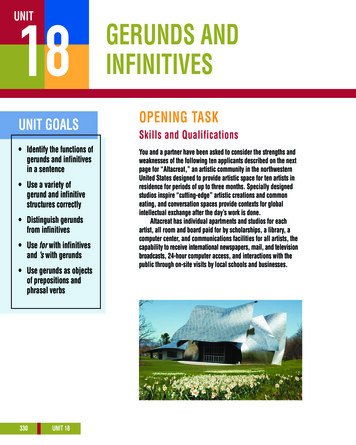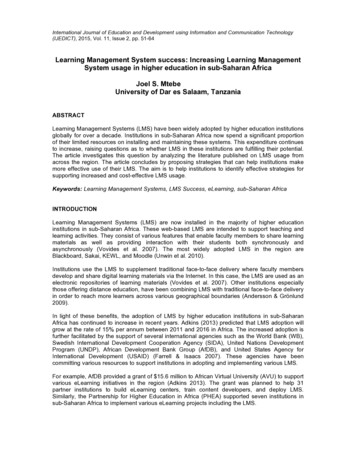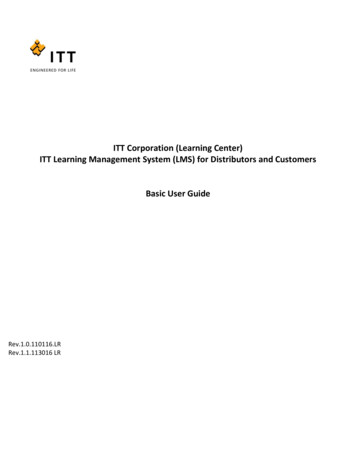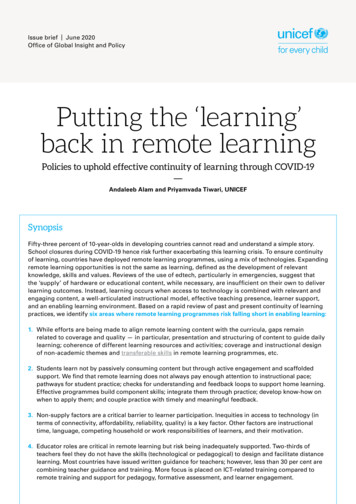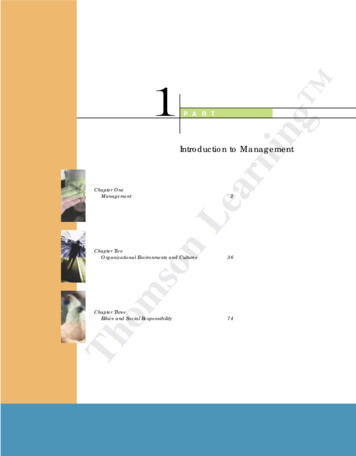
Transcription
ng 1P A R TarniIntroduction to ManagementChapter OneManagementnLe236omsoChapter TwoOrganizational Environments and CulturesThChapter ThreeEthics and Social Responsibility74
ng arniLe1nC H A P T E RWhat Really Happened?soWhat Would You Do?What Does It Take to Be a Manager?5. What Companies Look for in Managers6. Mistakes Managers Make7. The Transition to Management: The First YearWhy Management Matters8. Competitive Advantage through People PHOTODISC/GETTY IMAGESThWhat Do Managers Do?3. Kinds of Managers3.1 Top Managers3.2 Middle Managers3.3 First-Line Managers3.4 Team Leaders4. Managerial Roles4.1 Interpersonal Roles4.2 Informational Roles4.3 Decisional RolesKey TermsWhat Would You Do-II?Management DecisionsDevelop Your Managerial PotentialomWhat Is Management?1. Management Is.2. Management Functions2.1 Making Things Happen2.2 Meeting the Competition2.3 Organizing People, Projects, and Processes2.4 Leading
ManagementTharnimer HR director, said, “You have a groupof five, six, ten people—all best friendswho went to school together. If one getsdisillusioned, it affects the rest of thepeople in that group. . . . You kind ofhave to walk on eggshells to provide disciplinary conversation or feedback.Whatever you say to one person will getout to everyone else in the group.”After several months of continuousgriping and out-of-control meetings, afrustrated Charlie Kim fired a dozen employees who he felt were at the root ofthe problems. He said, “We were spending too much time managing negativepeople.” But because of the tight friendships in the company, most of which hadexisted before people were hired, anotherhalf-dozen people immediately quit.Morale and company performance plummeted. Instead of making things better,the firings made them much worse. Kimlost sleep and became depressed.Slowly he came to the realization thathe, too, needed to change for the company to succeed, that what had workedwhen the company had just 10 employees was not going to work when it had130. After some encouragement fromfriends, advisors, and investors, he beganto consider the following issues: Whatare my primary responsibilities as a topmanager? Does that include keeping workers happy and comfortable? Making theLenomHeadquarters, NextJump, Inc., NewYork, New York. Charlie Kim started hisnew company, NextJump, after an exhausting two years at Morgan Stanley, aNew York investment bank, where heworked 80-hour weeks. Kim figured thatmost people left Morgan Stanley for jobsat companies that allowed them to havepersonal lives. “People were working until 1 A.M., drinking coffee, eating junk,”he says, “and they were miserable.” Kimcommitted to run NextJump in a fairway for employees. He backed up hiscommitment by not allowing employeesto work late nights or weekends. He said,“I don’t want anyone to be drained or exhausted.” And unlike many tech startups,beds, cots, and futons weren’t permitted.Said Kim, “If you need to sleep, youshould go home.” Alice Park, NextJump’sdirector of product development, saidgetting kicked out of the office by theboss was “a little strange to me at first. Ihad come from an investment bank,where it seemed normal to work until 9or 10 at night. But people here have adifferent style of working.”Kim also figured that work would bemore fun if everybody knew each other,so within a year, he brought in three ofhis friends as partners. This partnershipworked so well that NextJump continuedits policy of hiring friends. As NextJumpgrew from 30 to 105 employees in justthree months, its employees ended upworking with their college roommates,their prom dates, and their brothers andsisters. The company even displayed a diagram of a “family tree,” which showedhow everyone in the company was connected to everyone else. As a finishingtouch to making NextJump a great placeto work, Kim bought gym membershipsfor everyone (and then encouraged themto work out whenever they wanted) andhired a masseuse to give massages oncompany time.For a while, NextJump was a goodcompany and an even better place towork. But problems soon emerged. Keypeople often missed important meetingsbecause they were at the gym. Furthermore, even when everyone could attend,staff meetings became turbulent, toolarge, and disorganized. Meetings hadbeen well run when the company wassmall, but now they turned into arguments about key company decisions,such as determining which products tosell, or whether the company should offer print products in addition to those itsold online. These problems were compounded when employees openly questioned the decisions of management andanyone else outside their small circle offriends. Peter Rommeny, NextJump’s for-soWhat Would You Do?ng o n e
got that? If you were the CEO of NextJump, what would you do?Sources: P. Kruger, “Stop the Insanity! A NewGeneration of Dotcom Entrepreneurs Are Creating Companies that Work—Without ExpectingPeople to Spend Every Waking Moment atWork. Here’s How to Build a Saner Startup,”Fast Company, 1 July 2000, 240. R. Silverman,“For Charlie Kim, Company of Friends Proves aLonely Place—A Dot-Com Founder Brought InBuddies and Colleagues; All Was Fine—on theWay Up,” The Wall Street Journal, 1 February2001, A1.arning transition from employee to manager hasbeen one of the most stressful in my life. Aremy experiences unique? What mistakes domanagers typically make? Finally, whatdoes it takes to be a manager and have IThe issues facing Charlie Kim and NextJump are fundamental to any organization:What is management, and what do managers do? Good management is basic to startinga business, growing a business, and maintaining a business once it has achieved somemeasure of success.This chapter begins by defining management and discussing the functions of management. Next, we look at what managers do by examining the four kinds of managersand reviewing the various roles that managers play. Third, we investigate what it takes tobe a manager by reviewing management skills, what companies look for in their managers, the most serious mistakes managers make, and what it is like to make the toughtransition from being a worker to being a manager. We finish this chapter by examiningthe competitive advantage that companies gain from good management. In other words,we end the chapter by learning how to establish a competitive advantage through people.LeWhat Is Management?sonHave you ever noticed the difference between good and bad auto repair shops? Differences usually start with the service manager who greets you when you bring in your car.Understanding that most people don’t know much about cars, good service managers askdozens of detailed questions about the car’s problems, what it does, the noises it makes,and the circumstances under which the problems occur. When DaimlerChrysler wantedto make sure that all of its Chrysler dealerships had good service managers, it hired amanagement consulting firm to create the ServiceAnalyzer, a computer-based tool thathelps service managers at all Chrysler dealerships intuitively walk customers through aseries of questions that fully describe the car’s problem and when it occurs. DaimlerChrysler used the ServiceAnalyzer to solve problems and improve customer satisfaction.But what DaimlerChrysler was paying for when the ServiceAnalyzer was created wasgood management advice.1 Of course, DaimlerChrysler isn’t the only organization insearch of good management ideas. Nearly all companies are. In fact, it’s estimated thatcompanies paid management consultants over 138 billion for management advice lastyear.2 Clearly, companies are looking for help with basic management issues, like how tomake things happen, how to beat the competition, how to manage large-scale projectsand processes, and how to effectively lead people. This textbook will help you understand some of the basic issues that management consultants help companies resolve (andunlike DaimlerChrysler, this won’t cost millions of dollars).3Thom4After reading these next two sections, you should be able to1. describe what management is.2. explain the four functions of management.1. Management Is . . .Many of today’s managers got their start welding on the factory floor, clearing dishes offtables, helping customers fit a suit, or wiping up a spill in aisle 3. Similarly, lots of youwill start at the bottom and work your way up. There’s no better way to get to knowPART 1INTRODUCTION TO MANAGEMENT
PersonalProductivityTipyour competition, your customers, and your business. But whether you begin your career at the entry level or as a supervisor, your job is not to doDo You Know How Efficient Your Business Is?the work, but to help others do their work. Management is getting workany managers fail to keep track of one of thedone through others. Pat Carrigan, a former elementary school principalmost important outcomes in business: efficiency.who became a manager at a General Motor’s car parts plant, said, “I’veSummit Polymers initially paid 280,000 for robotsnever made a part in my life, and I don’t really have any plans to make one.to paint and dry the dashboard vents in ToyotaThat’s not my job. My job is to create an environment where people whocars. When Toyota showed Summit how to do thedo make them can make them right, can make them right the first time,same thing with 150 paint guns and much cheapercan make them at a competitive cost, and can do so with some sense of rehigh-intensity lights, efficiency soared as Summitproduced more with much less. Merck, a pharmasponsibility and pride in what they’re doing. I don’t have to know how toceutical company, improved efficiency by knockingmake a part to do any of those things.”4five weeks off the time it takes to launch new prodPat Carrigan’s description of managerial responsibilities indicates thatucts. If you want to improve how well your companymanagers also have to be concerned with efficiency and effectiveness in theis performing, keep close track of efficiency andwork process. Efficiency is getting work done with a minimum of effort,productivity.expense, or waste. For example, at Springfield Remanufacturing CompanySource: G. Harris, “The Cure: with Big Drugs Dying, Merck(SRC), the machines are shut off for a half an hour each week so that theDidn’t Merge—It Found New Ones—Some Inspired Research, Aided by a Bit of Luck, Saves Company’s Indepen800 employees can break into small groups to study the company’s weeklydence—The Path to a Novel Painkiller,” The Wall Streetfinancial statements. With full information about the costs of labor, elecJournal, 1 January 2001, A1. N. Shirouzu, “Gadget Inspectricity, and raw materials, everyone at SRC can help increase efficiency bytor: Why Toyota Wins such High Marks on Quality Surveys—Hajime Oba is a Key Coach as Japanese Auto Makerdoing more with less cost and waste. For example, the workers learned thatSteps up U.S. Production—Striving to Reach Heijunka,” Theeach sale of a rebuilt No. 466 crankshaft contributes 17.60 an hourWall Street Journal, 15 March 2001, A1.toward paying overhead expenses. When they are able to rebuild thesecrankshafts quickly and efficiently, the additional inventory of finishedcrankshafts can generate as much as 170 a day that can be used to pay overhead costs,managementgetting work done through otherssuch as utility expenses or the salaries of scheduling and purchasing personnel. Countlessefficiencysmall, efficiency-minded choices like this have helped SRC become one of the mostgetting work done with minimum ofprofitable companies in its industry.effort, expense, or wasteBy itself, efficiency is not enough to ensure success. Managers must also strive for efeffectivenessfectiveness, which is accomplishing tasks that help fulfill organizational objectives, suchaccomplishing tasks that help fulfillas customer service and satisfaction. For instance, if you’ve ever walked into a Home Deorganizational objectivespot, the warehouse-sized hardware stores, you’ve probably had trouble getting someoneto help you. So has Dian Diemler, a loyal but frustrated Home Depot customer. Shesaid, “I’ve followed employees around the store while they help other people in order towait my turn.”5 To solve this problem, Home Depot has started a program called ServicePerformance Improvement (SPI) that prevents employees from running forklifts andstocking shelves between 8 A.M. and 8 P.M. Store manager Steve Moody also encourageshis employees to wait in the “neutral zone” at the front of the store (between the cashregisters and the store shelves) and to be aggressive in asking customers if they need help.The goal is to encourage orange-clad Home Depot employees to be efficient (by restocking shelves) and effective (by first helping customers).6Review 1Management Is . . .Thplanningdetermining organizational goalsand a means for achieving themomsonLearning Morganizingdeciding where decisions will bemade, who will do what jobs andtasks, who will work for whomleadinginspiring and motivating workers towork hard to achieve organizational goalscontrollingmonitoring progress toward goalachievement and taking correctiveaction when neededGood management is working through others to accomplish tasks that help fulfill organizational objectives as efficiently as possible.2. Management FunctionsTraditionally, a manager’s job has been described according to the classical functions ofmanagement: planning, organizing, leading, and controlling. Planning is determining organizational goals and a means for achieving them. Organizing is deciding where decisionswill be made, who will do what jobs and tasks, and who will work for whom in the company. Leading is inspiring and motivating workers to work hard to achieve organizationalgoals. Controlling is monitoring progress toward goal achievement and taking correctiveaction when progress isn’t being made.CHAPTER 1MANAGEMENT5
WhatReallyWorksMeta-AnalysisSome studies show that having two drinks a day increases life expectancy by decreas
a business, growing a business, and maintaining a business once it has achieved some measure of success. This chapter begins by defining management and discussing the functions of man- agement. Next, we look at what managers do by examining the four kinds of managers and reviewing the various roles that managers play. Third, we investigate what it takes to be a manager by reviewing
